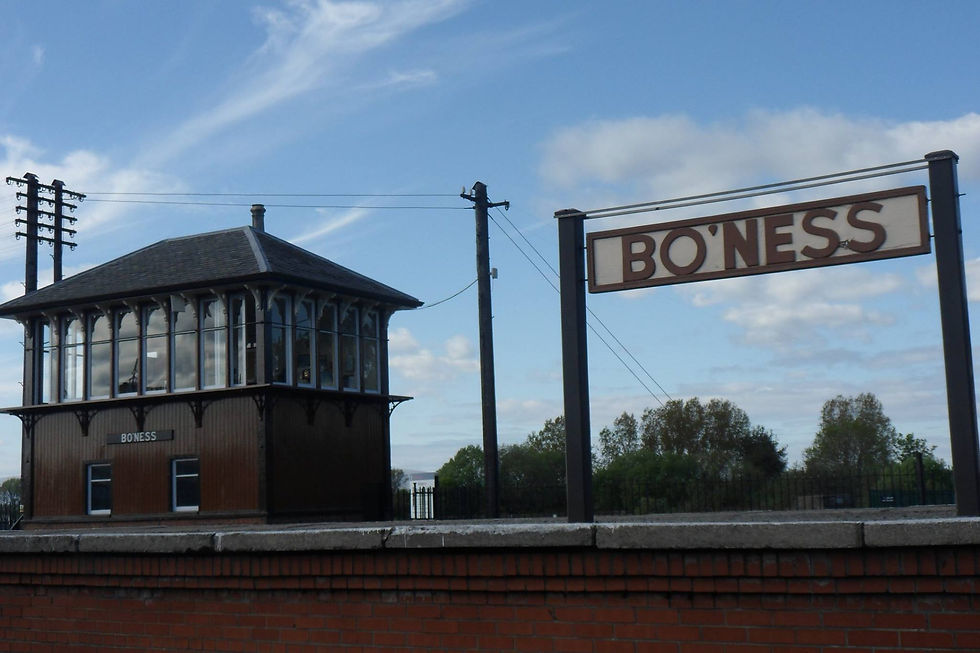- Walking With Brian
- Nov 6, 2023
- 4 min read
Updated: Dec 5, 2023
As a keen walker and industrial historian, I have passed by the Falkirk Wheel on several occasions and marvelled at the sight of boats being raised or lowered by a distance of 35 metres. The engineering masterpiece links the Forth & Clyde Canal with the Union Canal and neatly solves the issue of transferring vessels between two waterways that converge at vastly different elevations. The rotating boat lift replaces a flight of locks that previously required the best part of a day to negotiate. By contrast, a cycle of the wheel takes just five minutes to complete.

Until today, I had only observed the process from a distance. Now I had the chance to be in the centre of the action. Also present were Nicole and my mum, for whom the boat trip was a birthday gift. The wheel is located over two miles from Falkirk town centre and can be approached from the surrounding motorway network. Ample free parking is available an easy 10-minute walk from the site. We waited in line by the canal basin and watched the wheel in motion as the barge on the preceding tour was lowered back down to our level. The hour-long trip costs £17.40, with a small discount for concessions. We filed on board and - following the mandatory safety briefing - were soon being lifted towards the sky. The roofed barge had large windows and the landscape opened up around us. A pre-recorded commentary was provided and conveyed the history of the two canals and the construction of the wheel. Following decades of abandonment, both corridors were fully restored at the turn of the century as part of the Millennium Link project. This scheme involved the removal of 32 obstructions to navigation, the erection of 28 road bridges and the diversion of a motorway. The 35-mile Forth & Clyde Canal opened way back in 1790 and linked the east and west coasts. Formal closure came in 1963 when the M8 was built across the course of the canal. Boat traffic had been in terminal decline for many years and there was little appetite to keep the facility open. The Union Canal was officially shut in 1965 but the physical connection to the Forth & Clyde had been lost 30 years earlier when the locks were dismantled and infilled. The 31-mile stretch from Falkirk to Edinburgh opened for business in 1822 and was built on the contour principle, meaning it hugged the lie of the land rather than take a direct route. This resulted in a meandering passage but the engineering costs were dramatically cut. When the restoration project was launched, a swifter method of transferring traffic between the canals had to be found. The old system had been a labour-intensive operation as each of the 11 locks had two sets of gates that had to be opened and closed every time a boat passed through.

Two water-filled gondolas of equal weight are attached to the Falkirk Wheel. Should a barge enter, it displaces its own weight, thus adhering to the famous Archimedes rule. Therefore it makes no difference to the wheel operation whether a gondola is occupied or not, nor indeed how heavy an individual boat is. The mass of each compartment remains constant. The wheel is so finely balanced it just needs a gentle shove to get going - said to be the energy equivalent of boiling eight kettles. As one gondola gently descends, the other glides upwards. The physics aren't too difficult to get your head around and the whole spectacle is enhanced by the pleasing aesthetic qualities of the boat lift - said to resemble a double-headed Celtic axe. The individual sections were bolted together and tightened by hand. Once the rotation was complete, we puttered along the aqueduct that leads to a 200-yard concrete-lined tunnel. This subterranean passageway is also part of the millennium rebuild and took us under the main Edinburgh to Glasgow railway line and the remains of the Antonine Wall. The original lock staircase was located further to the east (it was built upon in the 1960s). We chugged towards the two "top locks" where the modern Falkirk Wheel complex connects to the original line of the Union Canal. At this point our boat turned round and headed back through the tunnel. Back at the wheel itself, we paused for around 10 minutes before entering the gondola. We were now facing the Forth Valley and the views were far better than on the outward trip. The surrounding landscape was largely flat and sitting at the top of the boat lift allowed us to see for miles around. The onboard guide pointed out a few landmarks and I managed to pinpoint the Kelpies in the distance. The world-famous steel sculptures stand 100 feet tall at the end of the Forth & Clyde Canal, four miles from the junction with the Union. The opening of the Falkirk Wheel in 2002 was a major economic boost for the general area. Around half a million visitors arrive each year. The subsequent development of Helix Park (home of the Kelpies) has also helped transform an industrial region into one that now offers a host of leisure options. We finished off the day by relaxing in the visitor centre café. It had been a fun experience with plenty history thrown in. Just my sort of thing.









